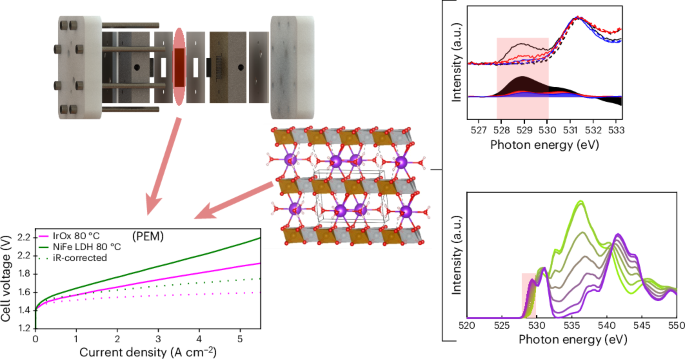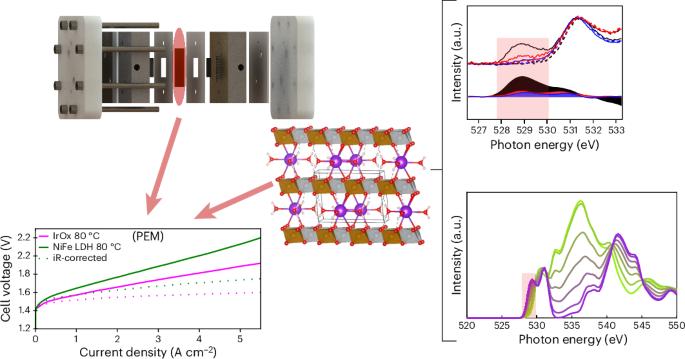High-performance anion-exchange membrane water electrolysers using NiX (X = Fe,Co,Mn) catalyst-coated membranes with redox-active Ni–O ligands
IF 42.8
1区 化学
Q1 CHEMISTRY, PHYSICAL
引用次数: 0
Abstract
Recent efforts in anion-exchange membrane water electrolysis (AEMWE) focus on developing superior catalysts and membrane electrode assemblies to narrow the performance gaps compared with proton-exchange membrane water electrolysis (PEMWE). Here we present and characterize Ir-free AEMWE cells with NiX (X = Fe, Co or Mn) layered double hydroxide (LDH) catalyst-coated membranes with polarization characteristics and hydrogen productivities approaching those of acidic PEMWE cells, achieving >5 A cm−2 at <2.2 V. Operando spectroscopy revealed a correlation between Ni4+ centres and redox-active O ligands with an O K-edge feature, attributed to µ3-O ligands in the γ-LDH catalytic phase via density functional theory calculations. This computational–experimental study challenges the previously assumed correlation between spectral O K-edge features and oxygen evolution reaction performance in Ni-based LDH catalysts and provides insights from the molecular to the technological level demonstrating how redox-active Ni–O species and innovative catalyst-coated membrane preparation boost AEMWE performance to values rivalling state-of-the-art PEMWE cell technology. Anion-exchange membrane water electrolysers have the potential to rival more costly acidic proton-exchange membrane electrolysers, but their performance and efficiency commonly still fall short. Now an anion-exchange membrane water electrolyser is prepared with a NiFe layered double hydroxide catalyst-coated membrane that achieves high current densities above 2 A cm−2 at 1.8 V and operando X-ray absorption spectroscopy is used to track the formation of the catalytically active γ-LDH phase.


使用具有氧化还原活性 Ni-O 配体的 NiX(X = Fe、Co、Mn)催化剂涂层膜的高性能阴离子交换膜水电解槽
最近,阴离子交换膜水电解法(AEMWE)的研究重点是开发优质催化剂和膜电极组件,以缩小与质子交换膜水电解法(PEMWE)的性能差距。在这里,我们介绍并表征了采用 NiX(X = 铁、钴或锰)层状双氢氧化物(LDH)催化剂涂层的无 Ir AEMWE 电池,其极化特性和氢气生产率接近酸性 PEMWE 电池,在 2.2 V 时达到 5 A cm-2。运算光谱显示了 Ni4+ 中心与氧化还原活性 O 配体之间的相关性,通过密度泛函理论计算,在 γ-LDH 催化阶段,O K 边特征归因于 µ3-O 配体。这项计算-实验研究挑战了之前假设的镍基 LDH 催化剂中 O K-edge 光谱特征与氧进化反应性能之间的相关性,并提供了从分子到技术层面的见解,展示了氧化还原活性 Ni-O 物种和创新的催化剂涂层膜制备如何将 AEMWE 性能提升到可与最先进的 PEMWE 电池技术相媲美的数值。
本文章由计算机程序翻译,如有差异,请以英文原文为准。
求助全文
约1分钟内获得全文
求助全文
来源期刊

Nature Catalysis
Chemical Engineering-Bioengineering
CiteScore
52.10
自引率
1.10%
发文量
140
期刊介绍:
Nature Catalysis serves as a platform for researchers across chemistry and related fields, focusing on homogeneous catalysis, heterogeneous catalysis, and biocatalysts, encompassing both fundamental and applied studies. With a particular emphasis on advancing sustainable industries and processes, the journal provides comprehensive coverage of catalysis research, appealing to scientists, engineers, and researchers in academia and industry.
Maintaining the high standards of the Nature brand, Nature Catalysis boasts a dedicated team of professional editors, rigorous peer-review processes, and swift publication times, ensuring editorial independence and quality. The journal publishes work spanning heterogeneous catalysis, homogeneous catalysis, and biocatalysis, covering areas such as catalytic synthesis, mechanisms, characterization, computational studies, nanoparticle catalysis, electrocatalysis, photocatalysis, environmental catalysis, asymmetric catalysis, and various forms of organocatalysis.
 求助内容:
求助内容: 应助结果提醒方式:
应助结果提醒方式:


